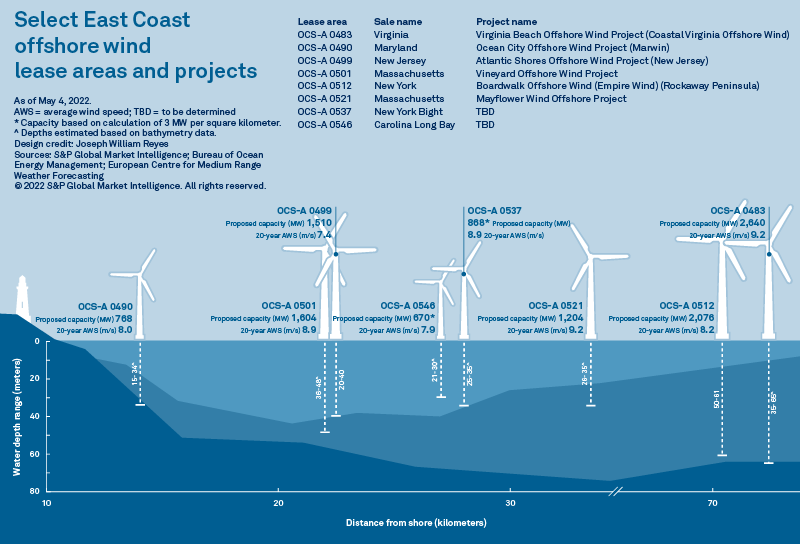S&P Global Offerings
Featured Topics
Featured Products
Events
S&P Global Offerings
Featured Topics
Featured Products
Events
S&P Global Offerings
Featured Topics
Featured Products
Events
Banking & Capital Markets
Economy & Finance
Energy Transition & Sustainability
Technology & Innovation
Podcasts & Newsletters
Banking & Capital Markets
Economy & Finance
Energy Transition & Sustainability
Technology & Innovation
Podcasts & Newsletters
S&P Global Offerings
Featured Topics
Featured Products
Events
18 May, 2022

By Allison Good
Soaring project costs and supply chain disruptions are contributing to the cautious approach most U.S. utilities are taking to the country's offshore wind buildout, as European energy firms step in to bid on and win acreage.
An Invenergy LLC and energyRe LLC joint venture backed by investors including Blackstone Inc. was the only U.S. consortium to win a lease area in February's New York Bight auction that totaled $4.37 billion, as established players Avangrid Inc. and Public Service Enterprise Group Inc., or PSEG, bowed out. Prices for the Carolina Long Bay federal auction on May 11 exceeded what Avangrid paid in 2017 to lease the area for the Kitty Hawk Offshore Wind Farm.
Though Duke Energy Corp. won a 55,154-acre lease for $155 million during the auction, North Carolina's largest utility still faces significant regulatory hurdles since the state legislature has not codified into enforceable policy Gov. Roy Cooper's goals for 2.8 GW of offshore wind capacity by 2030 and 8 GW by 2040.
"Support from the [North Carolina Utilities Commission] will be essential for the company to be able to ultimately proceed with development," Guggenheim Securities LLC told clients May 12.
The proposed carbon reduction plan Duke filed with North Carolina regulators May 16 included options adding up to 1,600 MW of offshore wind.
Eversource considers divestment
Given uncertainties surrounding costs and timing for its U.S. offshore wind portfolio, fellow East Coast developer Eversource Energy plans to monetize its holdings through a potential sale of all or part of the company's 50% stake in an offshore wind joint venture with Danish power company Ørsted A/S.
"The New York Bight leases were a point of inflection for this company," Eversource President and CEO Joe Nolan said May 5.

"We have some assets that are worth significantly more than we paid or invested in, and we see an opportunity to rotate and de-risk on behalf of our shareholders, which is really what the mission is," Nolan continued, with Eversource reaping "even greater levels of regulated investment, less financing needs, or a combination of the two" should a sale materialize.
Analysts at Wells Fargo Securities applauded the strategic review, noting that lengthy development timelines for the 130-MW South Fork Wind Farm, the 704-MW Revolution Wind Offshore and the 924-MW Sunrise Wind Offshore Farm already prompted Eversource to lower those projects' expected average return on equity "from the 'mid-teens' to 11[%]-13% with further cost pressures possible."
Scotiabank analysts agreed that the move made sense, given that each of Eversource's three planned projects has faced delays, pushing the earnings contributions by one to two years, and that the company's ratepayers cannot absorb added costs beyond the fixed-price contracts.
With those restrictions in place, "we increasingly viewed it as unlikely that [Eversource] would expand the offshore strategy beyond the existing lease areas," Wells Fargo wrote May 4. "And, as the Bight auction results strongly suggest, there appears to be plenty of developers champing at the bit to establish or expand their presence in the U.S."
Eversource does see opportunity build out interconnection infrastructure for offshore wind along the New England coast.
"The needs in offshore wind in terms of interconnection are extraordinary," Nolan said. "That's what we're very, very good at, and we're going to play to our strength."
European firms snap up U.S. assets
European companies, on the other hand, benefiting from greater experience developing such projects, are looking to expand their U.S. offshore wind holdings.
After Germany's EnBW Energie Baden-Württemberg AG and France's TotalEnergies SE won a $795 million bid as Attentive Energy LLC during the New York Bight auction, EnBW announced it will sell subsidiary EnBW North America and its offshore wind operations in the U.S. to TotalEnergies. France's energy giant added a 54,937-acre lease in the Carolina Long Bay area to its portfolio with a bid of $160 million.
Developers like Equinor ASA and BP PLC are also willing to invest in the infrastructure needed to build out the Atlantic Coast's offshore wind capabilities. The European firms in March agreed to turn a Brooklyn, N.Y., marine terminal complex into a major offshore wind development port.
PSEG and Dominion Energy Inc., in contrast, are not currently looking to build capacity beyond New Jersey's Ocean Offshore Wind Farm and Coastal Virginia Offshore Wind, respectively, though Dominion is building a Jones Act-compliant ship to support turbine installation.
PSEG could opt to participate in Orsted's Skipjack 2 offshore Maryland wind farm, but President and CEO Ralph Izzo said May 3 the company does not plan to be involved in additional projects if "they exceed what the demands are in the regulated utility on a risk-adjusted basis."
Dominion is similarly cautious when it comes to building additional capacity.
"We're a state-regulated pure-play utility, and we're interested in state-regulated projects like the one that we're doing in Virginia. That's our interest in offshore wind," President and CEO Robert Blue said May 5.
There may not be any additional auctions for Atlantic Coast acreage unless Congress repeals a 10-year moratorium signed by former President Donald Trump, set to take effect this summer. The American Clean Power Association, the trade group representing the renewable power industry, said the Carolina Bay results show "the strong demand for clean energy" and should convince Congress to overturn the ban.
S&P Global Commodity Insights produces content for distribution on S&P Capital IQ Pro.
